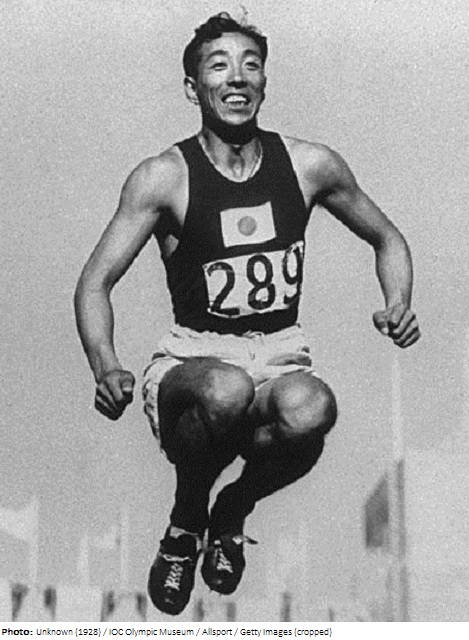Chuhei Nanbu

Biographical information
| Roles | Competed in Olympic Games |
|---|---|
| Sex | Male |
| Full name | Chuhei•Nanbu |
| Used name | Chuhei•Nanbu |
| Original name | 南部•忠平 |
| Born | 24 May 1904 in Sapporo, Hokkaido (JPN) |
| Died | 23 July 1997 in Suita, Osaka (JPN) |
| Measurements | 170 cm / 67 kg |
| Affiliations | Waseda University, Tokyo (JPN) / Mizuno Track Club, Osaka (JPN) |
| NOC |  Japan Japan |
| Medals | OG |
| Gold | 1 |
| Silver | 0 |
| Bronze | 1 |
| Total | 2 |
Biography
In 1928 Chuhei Nanbu was ninth in the triple jump and fourth in the long jump and started in the 4x100 relay. In Los Angeles he won medals in the triple jump (gold) and long jump (bronze), finishing fifth with the sprint relay. He was the first athlete to simultaneously hold the world records in the long and triple jump. His long jump record of 7.98 metres stood for almost 40 years as a national best. An accomplished sprinter, Nanbu won the 100 metres at the 1930 and 1933 Japanese Championships and in 1931 set a Japanese record with 10.6. In addition, he won two titles in the 4x100 m relay and six consecutively in the long jump, although never in the triple jump. At the Far Eastern Games Nanbu won one gold, two silver and three bronze medals from 1925-30.
A native of Sapporo in Northern Japan and the son of a liquor store owner, Nanbu tried to strengthen his physical fitness and joined the track & field club. In junior high school, he already excelled in the sprints and long jump. His first major competition was the national trials for the 1924 Olympics. Although he beat Mikio Oda at the trials, he did not go to Paris.
Nanbu practiced indoors during the winter, often running up and down the stairs in department stores. He then studied at the prestigious Waseda University and initially joined South Manchuria Railway after graduating. He soon moved to Senriyama near Osaka, where he worked for the sporting goods manufacturer Mizonu and trained at the nearby Kansai University, together with Oda. Two years after the Los Angeles Olympics, Nanbu injured his Achilles tendon and had to retire from active sports.
He later became coach, sports official and sports editor for the newspaper Mainichi Shimbun, and also worked as a university professor at Hokkaido Women’s Junior College (later Hokusho University) and president of Tottori Women’s Junior College. In 1964 he was the manager of the Japanese Olympic team. In 1983 Nanbu was awarded the Olympic Order in Silver. He eventually died of pneumonia. His name is seen written in many sources as Nambu.
The International Federation of Athletics Federations (IAAF) elected 12 athletes including Nanbu for the Heritage Plaque, established in 2018. A monument was erected in the Maruyama stadium in his honor and a bust was installed in a building of Hokkai-Gakuen University, both in Sapporo. The Hokkaido Prefectural Sports Center displays his medals and other memorabilia in the Chuhei Nanbu Corner.
Personal Bests: 100 – 10.5 (1933); LJ – 7.98 (1931); TJ – 15.72 (1932).
Results
| Games | Discipline (Sport) / Event | NOC / Team | Pos | Medal | As | |
|---|---|---|---|---|---|---|
| 1928 Summer Olympics | Athletics |  JPN JPN |
Chuhei Nanbu | |||
| 4 × 100 metres Relay, Men (Olympic) | Japan | 3 h3 r1/2 | ||||
| Long Jump, Men (Olympic) | 9 r1/2 | |||||
| Triple Jump, Men (Olympic) | 4 | |||||
| 1932 Summer Olympics | Athletics |  JPN JPN |
Chuhei Nanbu | |||
| 4 × 100 metres Relay, Men (Olympic) | Japan | 5 | ||||
| Long Jump, Men (Olympic) | 3 | Bronze | ||||
| Triple Jump, Men (Olympic) | 1 | Gold |
Special Notes
- Listed in Olympic Order Recipients (1983 (Silver))
Errata
Date of birth listed as 27 May 1904 in some sources (Japanese Wikipedia) and also listed as that in "Japanese All Time top 100 performers list as of 1945" compiled by Shiro Kato, Sakae Sone and Tatsumi Senda. Our DOB of 24 May 1904 confirmed by a Brazilian immigration card from 1963.